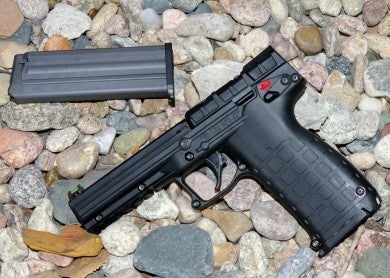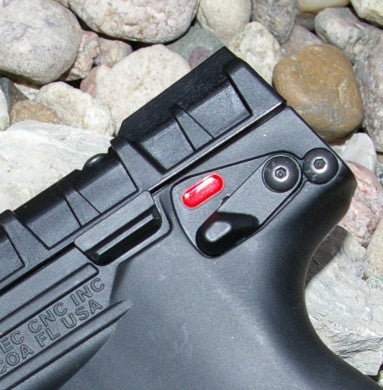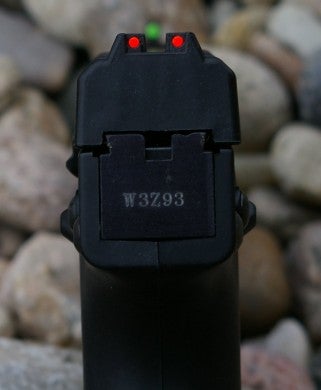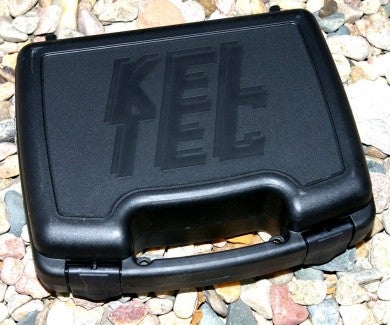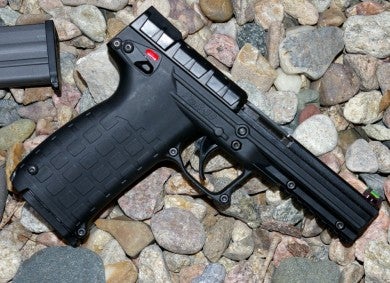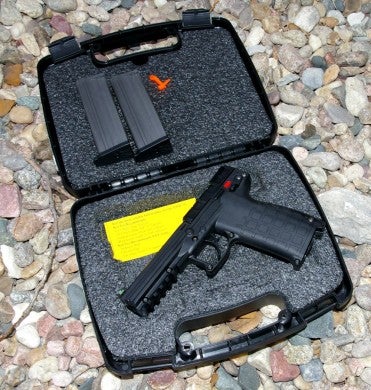Kel-Tec PMR-30 .22 Magnum pistol
versatile and low cost fun
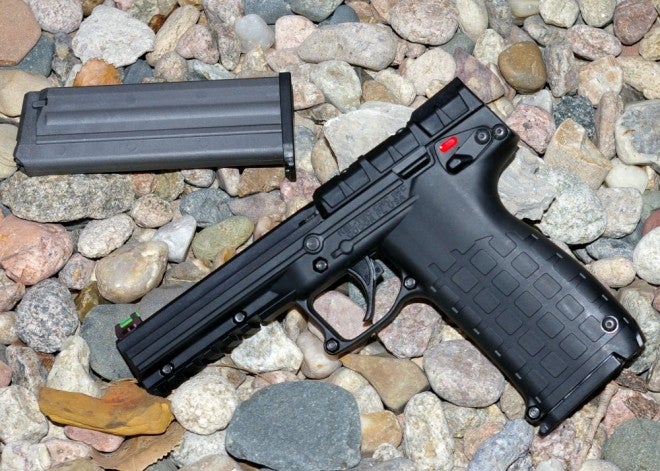
Regardless of what everyone says a gun should look like, Kel-Tec has always bucked the normal path that other manufacturers have followed with truly unique and innovative product designs. The Kel-Tec PMR-30 translates to Pistol Magnum Rimfire 30-shot and is yet another innovative firearm which fills a niche in the market with a very fun 30-shot .22 WMR semi-auto pistol.
Fit, feel, and features
The gun’s polymer frame fits tightly, and the various materials used in the construction all have a soft buffed finish. Despite the light weight, the PMR-30 is a solidly built gun.
As with any of the Kel-Tec firearms, the PMR-30 is unlike anything else on the market. The ergonomics do not feel odd, but they are different from typical pistol due to the size and shape. Part of that different feeling is the grip angle, with a deeper grip that accommodates the .22 Magnum round. The other quite noticeable trait is the weight, which makes for a fast handling and packable trail gun. At 13.6oz unloaded and 19oz loaded, the PMR-30 feels like a well built pellet pistol.
The Kel-Tec PMR-30 comes with two magazines, the pistol, and a nice hard case.
The pistol itself makes innovative use of materials. The slide and barrel are made from 4140 steel, and the frame is machined from 7075 aluminum. The grip, slide cover, trigger, mag release, and safety levers are glass reinforced Nylon (Zytel), much like the other Kel-Tec Pistols. The two included 30-round magazines are also very durable Zytel, with handy round count ports.
Dual opposing extractors increase the reliability of the rimfire rounds for positive extraction. The Kel-TecPMR-30 features a heel magazine release, instead of a typical thumb release, which was still plenty fast to load and adds to the complete ambidextrous function of the pistol. Recoil is managed by the urethane recoil buffer and captive coaxial recoil springs. Dis-assembly is via a simple single-pin removal which breaks the gun down into slide, barrel, buffer, and recoil springs.
The PMR-30’s trigger is a surprisingly crisp single action with an over-travel stop. My expectation was that the trigger would be the mushy trigger of my Sub-2000, but this was a really good trigger for an inexpensive pistol. The manual safety is a standard thumb activated ambidextrous safety lever (up for SAFE, down for FIRE), which even my stumpy thumbs could reach and operate.
The sights are high visibility fiber optics, with the front green and rear orange of different colors. These sights were fast to pick up and easy to see in all ambient light levels. Surprisingly, with so much zytel used, on the gun the front sight is dovetailed aluminum front sight which provides windage adjustment. Elevation is fixed on the PMR-30. The pistol also has an optional accessory mounts for several popular red dot sights, which provide mounting just in front of the rear sight. However, a plain old picatinny mount up top would have been nice for other optics. If you want to mount a laser or weapon mounted light, then the PMR-30 includes a standard 1913 picatinny rail under the barrel.
Functions
The Kel-Tec PMR-30 design goals were to provide a lightweight, full size pistol chambered for the flat-shooting and surprisingly powerful .22 Magnum cartridge (.22WMR). The power of this round in many respects matches that of the .380 round for defense, sport, and hunting, with much lower recoil even in this ultra-light gun.
The PMR-30 operates on a unique hybrid auto-adjusting blowback/locked-breech system, which Kel-Tecindicates allows for the use of a wide variety of ammunition and varying velocities. The system automatically adjusts between locked breech and blowback operation, depending on the pressure of the cartridge.
A friend and I worked the gun over hard with about 400 rounds of various Super X, CCI, and Federal rounds and had no failures to fire, feed or extract. This is a highly reliable gun which I would feel comfortable using for self-defense or survival.
Kel-Tec has succeeded where others have failed by producing a double stack magazine that holds 30 rounds and fits completely in the grip of the pistol. Of note: if you just start stuffing rounds in as I did and load the ammo incorrectly, you will never get 30 rounds into the magazine and you will have feeding and functioning issues due to rim locking together. If, on the other hand, you follow the printed directions, which detail a technique that combines a 5.56 mag reload and .22 rimfire mag reload, you can get the 30 rounds in and not have any functionality issues whatsoever. So, be sure to read the manual on this gun.
Much like is the case with a Glock, the slide lock lever is noted as not being a slide release. The suggested method of manipulation is to release the slide via pulling back on the slide to release. A problem I found with this was that my hands never felt like they had a great grip on the slick zytel slide, but maybe some skateboard tape in between the ribs would help. The lock lever will hold back the slide after the last shot, and it also provides for manual slide lock lever use. The heel magazine release is different from the now standard thumb release, but with 30 rounds in the magazine and +1 in the chamber, the need to reload is doubtful in all but the most extreme situations, and even then mag changes will still be quick.
Thirty rounds, let’s contemplate that. That’s three mag changes on any standard .22 semi-auto and five revolver reloads. This is a load of ammo is a lightweight, standard size gun that just keep s shooting and shooting. My buddy and I kept saying, “geez I have to be empty by now”, but 30 rounds makes for a long period of shooting.
Accuracy and final thoughts
Buyers of the PMR-30 will have to do a little work to figure out which ammo shoots best in their gun. Figure that out and buy a stack of that ammo. My accuracy results were pretty varied. With CCI Maxi-Mags the accuracy of this gun was quite good, but with the Winchester Super X rounds, it was what I would term as combat accurate. For a light weight gun and for a pistol hunting, where most shooting is in the 2-25 yards range, this gun has more than adequate accuracy with the right ammo and could keep golf balls and soda cans dancing consistently at 25 yards off hand. My best group with the CCI rounds were .86”, which is quite good for a reliable and powerful gun that is priced on the street for $300-$350.
Average 5-shot groups at 25 yards off a rest
- CCI Maxi-Mag JHP 40gr: Accuracy 1.3”
- Winchester Super X.22WMR FMJ 40gr: Accuracy 3.1”
- Federal .22WMR JHP 50gr: Accuracy 2.25”
When I first picked up the Kel-Tec PMR-30 my first thought was this would make the ultimate gun for a lightweight bug out and field bag. Two 30-round magazines is a ton of ammo at your disposal, and tucking in an extra box of ammo is certainly not going to add a ton of weight to a grab and go bag. The reality though is that this gun is more than that.
The PMR-30 is a blast to shoot — it produces pleasant little fireballs as the sun starts to hide for the evening, and has very mild recoil, all for an low price. The price of .22 WMR ammo is about the same as inexpensive 9mm ammo these days, but for the hunter, sportsman, or survivalist there is a big weight difference between the rounds and firearm required for each. The .22 WMR is the key to this gun’s flexibility. If it was a standard .22LR it would be underpowered for defensive use or larger game, and if it was a larger caliber the grains of lead would start to add up and drastically increase the weight of ammo in the magazine and extra rounds carried.
This is a great gun for a lot of different duties. The Kel-Tec PMR-30 is the quintessential trail and pack gun that could handle all manner of beast and odd situation, all in a lightweight package that is only 19oz when fully loaded. It is light to pack, ammo is relatively inexpensive, and it’s easy to operate equally with either hand. Having 30 rounds on tap in this size gun is just plain fun, but could really be helpful in a defensive situation. Admittedly, the grip angle took a little to get used to, but with a few rounds down range, I like this gun more and more as I shoot it.
Specs
- Calibers: .22 Magnum (.22WMR)
- Weight unloaded: 13.6oz. 385.6g
- Loaded Magazine: 6oz. 170.1g
- Length: 7.9″ 200.7mm
- Height: 5.8″ 147.3mm
- Width: 1.3″ 33.0mm
- Barrel length: 4.3″ 109.2mm
- Sight radius: 6.9″ 175.3mm
- Energy (40gr): 138ft-lbs 187J
- Capacity: 30 rounds
- Trigger pull: 4-6 lbs 17.8-26.7N
Blog Table of Contents
